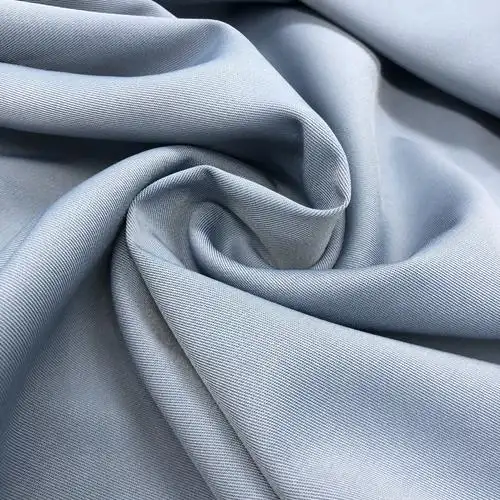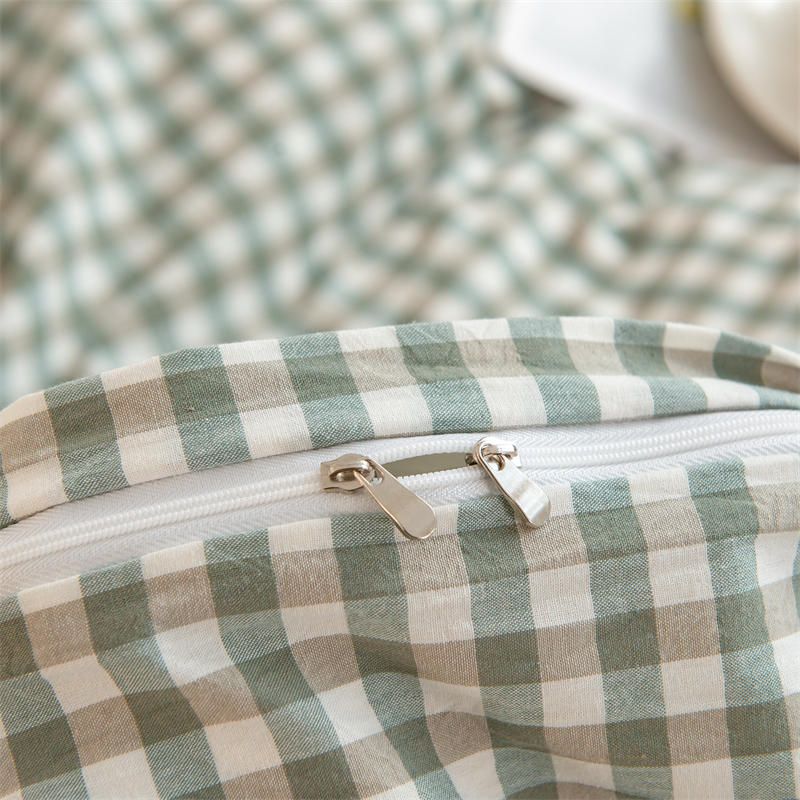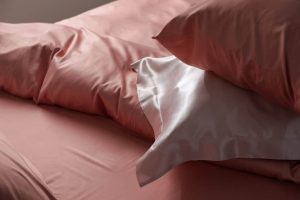In the pursuit of better sleep, cotton fitted sheets have become an essential smart choice for modern households. Unlike traditional flat sheets, this intelligently designed bedding features elasticated corners or elastic straps that create a 360-degree snug protective structure, securely wrapping the mattress to effectively prevent shifting and bunching during sleep. Cotton material, with its natural skin-friendly properties and excellent breathability, holds over 90% of the global fitted sheet market share, making it the preferred choice for consumers. This comprehensive guide explores everything about cotton fitted sheets, from core advantages to selection techniques, material differences to maintenance methods, helping you make informed purchasing decisions that truly enhance your sleep experience.

What Are Cotton Fitted Sheets? Redefining Mattress Protection
Cotton fitted sheets are fabric covers designed to be placed directly over mattresses, featuring tailored construction with elasticated corners or elastic straps that create a 360-degree protective structure. Unlike the flat rectangular design of traditional sheets, fitted sheets have square cutouts at all four corners that are sewn with elastic materials, forming a stretchable wrapping frame. This design allows the fitted sheet to snugly hug the mattress like a well-fitted “sock,” staying firmly in place without movement.
The core function of fitted sheets is to protect mattresses from dust, stains, and wear while providing a comfortable direct sleeping surface. Compared to regular flat sheets, fitted sheets offer practical benefits of non-slip stability and dust protection, with more precise requirements for mattress size compatibility. Standard fitted sheet sizes range from 120cm×200cm to 180cm×200cm, with custom options available up to 220cm×240cm. Thickness compatibility is categorized into standard (≤20cm), deep (20-30cm), and extra-deep (≥30cm) versions.
The Outstanding Advantages of Cotton Fitted Sheets
Cotton fitted sheets combine the natural benefits of cotton material with the practical design of fitted sheets, enhancing sleep experience in multiple aspects.
Anti-Slip Stability: The elastic bands create secure restraint that effectively prevents fabric movement during sleep, eliminating daily readjustments. This stability makes them particularly suitable for active sleepers, children, and households with pets, ensuring smooth surfaces throughout the night and saying goodbye to the frustration of traditional sheet “migration.”
Comprehensive Protection: Cotton fitted sheets completely cover the mattress surface and sides, preventing dust from penetrating mattress crevices and reducing cleaning frequency. As the “first line of defense” for mattresses, they effectively block direct damage from stains and liquid spills, extending mattress lifespan.
Health and Comfort: Cotton material offers natural skin-friendliness and breathability, helping regulate body temperature to maintain dry comfort during sleep. Cotton fabric also possesses good antibacterial properties that can effectively inhibit bacteria and mite growth, maintaining clean bedding environment. For people with sensitive skin, cotton provides a safe and gentle option.
Enhanced Convenience: Fitted sheets use a simple slip-on installation method that can be completed within one minute, saving 50% of setup time compared to traditional flat sheets. Reinstallation after washing is equally straightforward, significantly reducing daily bed-making burdens.
| Feature | Cotton Fitted Sheets | Traditional Flat Sheets |
|---|---|---|
| Stability | 360-degree fit, no movement | Prone to sliding and bunching |
| Ease of Installation | Completed within 1 minute | Requires repeated adjustments |
| Coverage | Full surface and side protection | Surface coverage only |
| Maintenance Frequency | Reduced cleaning needs | Frequent straightening required |
| Material Comfort | Natural, skin-friendly, breathable | Depends on material |
How to Choose the Right Cotton Fitted Sheet? Professional Selection Guide

Selecting the right cotton fitted sheet requires considering multiple professional factors, from size measurements to material parameters – every detail affects the final user experience.
Precise Size Measurement: Before purchasing fitted sheets, accurately measure the mattress length, width, and thickness, keeping error within ±2cm. Particularly note that if using a mattress protector, include its thickness in calculations to prevent insufficient coverage. Choose sheets 3-5cm larger than actual measurements to accommodate potential cotton shrinkage.
Elastic Band Quality Check: Elastic bands are crucial to fitted sheet functionality, with elasticity coefficient being vital. High-quality fitted sheets should have elastic bands with stretch recovery rate exceeding 85% to prevent loosening. Check elastic width and stitching durability to withstand repeated stretching and washing.
Understanding Cotton Parameters: – Combed Cotton vs Regular Cotton: Combed cotton undergoes multiple processes removing short fibers and impurities, resulting in finer, more durable fabric less prone to pilling. – Thread Count: Typically indicated by “40s,” “60s,” “80s” – higher numbers mean finer yarns, tighter weave, and smoother texture. For daily use, choose 60s or higher for optimal comfort and value. – Cotton Grade: Long-staple cotton, Xinjiang cotton, Egyptian cotton vary in quality, with 100% long-staple cotton being the primary material for premium fitted sheets.
Safety Standard Certifications: Check product compliance standards; home textiles should meet national standards. For maternal and infant use, sheets must pass Class A certification, the strictest textile safety standard. Class A products contain no formaldehyde, carcinogenic aromatic amines, or other harmful substances, suitable for direct skin contact.
Deep Dive into Cotton Material: Beyond Just “Cotton”
Behind the “cotton” label lies rich technical knowledge; understanding these professional details helps consumers identify truly high-quality fitted sheets.
Natural Characteristics of Cotton: Cotton fabric features excellent breathability and moisture absorption, helping regulate body temperature to maintain dry comfort during sleep. The hollow structure of cotton fibers quickly absorbs and dissipates body moisture, proven in sleep studies to positively impact thermal comfort and sleep quality. Compared to synthetic fibers, cotton fitted sheets reduce stuffiness during sleep, especially suitable for people prone to sweating.
Differences Between Cotton Types: – Regular Cotton: Basic cotton material, soft and comfortable, good value, but may contain short fibers and potentially pill over time. – Combed Cotton: Specially processed to remove short fibers, leaving long, uniform cotton fibers that create smoother, more durable fabric resistant to pilling. – Long-Staple Cotton: Uses longer fiber cotton that can be spun into higher thread counts, delivering finer, softer texture. Premium products typically use 60s or higher high-thread-count dense weaving. – Organic Cotton: GOTS-certified organic cotton grown without chemical pesticides or fertilizers, suitable for sensitive skin and environmentally conscious consumers.
Cotton vs Other Common Materials: While various materials like Tencel, and cooling fabrics exist in the market, cotton maintains the widest consumer acceptance. Tencel offers smooth coolness suitable for summer; cooling fabrics blend polyester with cellulose materials with surface cooling treatment; cotton remains the preferred choice for most households due to its all-season adaptability, natural origin, and skin-friendly properties. Research shows different fiber types affect sleep quality differently depending on individual physiology and environmental temperature, but cotton bedding demonstrates balanced performance in thermal comfort and skin compatibility.
Seasonal Adaptability of Cotton Fitted Sheets: The Ideal Year-Round Choice
The natural characteristics of cotton fitted sheets provide unique temperature regulation capabilities that adapt to seasonal climate changes, delivering comfortable sleep experiences throughout the year.
Spring-Summer Breathability: During warmer seasons, cotton’s breathability and moisture-wicking properties play crucial roles. Cotton fibers quickly absorb sweat from skin surface and facilitate evaporation, maintaining dryness during sleep. Studies indicate bedding material breathability significantly impacts sleep quality, particularly in warm environments. Compared to summer-specific materials like cooling fabrics and Tencel, cotton provides more natural touch without excessive coolness discomfort.
Autumn-Winter Warmth and Comfort: In colder seasons, cotton fitted sheets demonstrate different advantages. The hollow structure of cotton fibers traps air, forming natural insulation that provides warmth without stuffiness. Compared to winter materials like flannel and coral fleece, cotton generates no static electricity, being more skin-friendly during dry seasons. For cold-sensitive individuals, choose thickened quilted fitted sheets that add “blanket”-like warmth to mattresses, enhancing winter sleep comfort.
Care and Cleaning of Cotton Fitted Sheets: Secrets to Extending Lifespan
Proper maintenance not only preserves the appearance and comfort of cotton fitted sheets but significantly extends their service life. Follow professional care guidelines to maximize your investment value.
Cleaning Guidelines: For initial wash, recommend turning inside out, using neutral detergent to extend lifespan. For regular cleaning, suggest washing at least every two months in winter, monthly in summer, and ensure complete drying before use to prevent mattress dampness. Cotton fitted sheets support machine washing but recommend gentle cycle to avoid fiber damage and deformation from high-speed agitation.
Drying and Storage Essentials: Avoid high-temperature sun exposure for cotton fitted sheets to prevent fiber brittleness and fading. Optimal method is natural air drying; if using dryer, select low heat setting. Ensure complete dryness before storage, fold neatly and place in ventilated dry area. May add natural insect repellents but avoid direct contact with sheet fabric.
Solving Common Issues: – Shrinkage: Cotton products may naturally shrink 3%-5%; purchase with size allowance. Choose pre-shrunk products to minimize this issue. – Wrinkle Treatment: Cotton material wrinkles easily; iron while slightly damp using medium temperature. High-thread-count dense cotton fabrics reduce wrinkling. – Color Maintenance: For dark colors, avoid mixing with light-colored items during first few washes. Choose reactive dye printing products with color fastness level 4 or above, maintaining color after 30 machine washes.
Market Trends and Consumer Preferences
As the home textile industry grows, bedding represents a core category. Within this market, cotton fitted sheets continue dominating while evolving to meet modern consumer demands.
Design Trends: 2024 fitted sheet designs show diversification trends. Color options include solid colors and jacquard patterns, with solid colors gaining urban professional preference for their simple yet elegant design that easily complements various bedroom styles. Meanwhile, Chinese-style fitted sheets with unique embroidery craftsmanship and cultural elements attract traditional culture enthusiasts.
Changing Consumer Preferences: Modern consumers focus not only on fitted sheet appearance but also material safety, environmental standards, and functional performance. Rising popularity of GOTS-certified organic cotton products reflects growing consumer concern for environmental and health issues. Increased demand for Class A safety-certified products, particularly among maternal-infant groups, indicates heightened consumer awareness of product safety.
Functional Innovations: While maintaining cotton’s natural advantages, fitted sheet products continuously incorporate innovative technologies. Cotton fitted sheets with antibacterial treatment, anti-mite technology, and temperature regulation features are becoming widespread. Some premium models add antibacterial components to enhance hygiene standards, meeting consumer demands for healthier sleep environments.
Suitable Users and Scenarios for Cotton Fitted Sheets
The wide application scenarios and user adaptability of cotton fitted sheets contribute significantly to their popularity. Understanding optimal choices for different needs helps consumers find most suitable products.
Maternal-Infant Groups: For infants, particularly newborns, choose cotton fitted sheets with Class A certification. Class A standard represents China’s strictest textile safety requirements, ensuring no formaldehyde, carcinogenic aromatic amines, or other harmful substances. Recommend specially designed infant fitted sheets using 100% Xinjiang long-staple cotton, with four-corner widened elastic edging + middle splice seam design for perfect crib mattress fit. Splice design better accommodates mattress curves and corner depressions, preventing bulging and knotting issues.
Sensitive Skin and Allergy Sufferers: Cotton material is naturally hypoallergenic, suitable for sensitive skin individuals. For asthma or allergy sufferers, recommend high-thread-count dense cotton fitted sheets whose tight weaving effectively blocks dust mite penetration. Regular high-temperature washing of cotton fitted sheets reduces allergen accumulation, improving sleep environment quality.
Specific Living Scenarios: – Student Dormitories: Portable, easy-wash cotton fitted sheets sized for dorm beds create personal comfort space effortlessly. – Guest Room Preparation: Keep spare cotton fitted sheets ready for unexpected visitors, showing thoughtful hospitality. – Pet Households: Cotton fitted sheets effectively protect mattresses from pet claws and fur while being easy to clean and maintain.
Frequently Asked Questions
Addressing common consumer questions about selecting and using cotton fitted sheets with professional, clear answers.
Do cotton fitted sheets shrink? Cotton products may naturally shrink 3%-5% during initial wash, characteristic of cotton fibers. Recommend purchasing pre-shrunk products or selecting slightly larger sizes than mattress dimensions. Follow label instructions, use cold water and gentle cycle, avoid high-temperature drying to minimize shrinkage.
How to identify genuine cotton fitted sheets? Beware of “pseudo-cotton” traps: some products labeled “cotton” actually blend polyester or viscose fibers. Always check composition labels for “100% cotton” or “combed cotton.” Identify through touch and observation: cotton fabric feels naturally soft, burns without hard lumps; synthetic fibers feel slightly slippery, burn and form hard lumps.
What’s the main difference between fitted sheets and flat sheets? Fitted sheets slip directly over mattresses secured by elastic, staying in place without bunching; flat sheets simply lay over mattresses, prone to sliding. Fitted sheets provide comprehensive protection covering mattress surfaces and sides; flat sheets only cover surfaces. Fitted sheets install more conveniently – slip on once; flat sheets require repeated straightening.
What’s the price range for cotton fitted sheets? Basic cotton fitted sheets approximately $50-100, suitable for budget constraints or short-term use; mid-range combed cotton + quilted versions approximately $120-250, offering strong comprehensive performance and good durability; premium custom options (like organic cotton, high-thread-count) $250+, suitable for users with highest quality requirements. Investing in quality cotton fitted sheets represents investment in long-term sleep health.
Conclusion: Investing in Cotton Fitted Sheets, Investing in Quality Sleep
Cotton fitted sheets are more than ordinary household items – they represent intelligent choices for enhancing sleep quality, protecting mattress investments, and optimizing life quality. They combine cotton’s natural skin-friendly breathability with fitted sheet design’s stability and convenience, solving traditional flat sheet sliding and bunching frustrations, allowing every day to begin and end with neat, comfortable bedding.
When selecting cotton fitted sheets, remember key elements: precise size measurements, quality cotton material (recommend combed or long-staple cotton), appropriate thread count (60s or higher for daily use), Class A safety certification (especially for maternal-infant use), and proper anti-slip design. Correct maintenance methods extend product lifespan maintaining long-term comfort.
As home textile technology advances, cotton fitted sheets continue evolving, incorporating more eco-friendly concepts, health technologies, and humanized designs. Whether purchasing for the first time or upgrading, investing in high-quality cotton fitted sheets will significantly enhance your sleep experience. After all, we spend one-third of our lives in bed, deserving the most comfortable, healthiest sleep environment possible.



